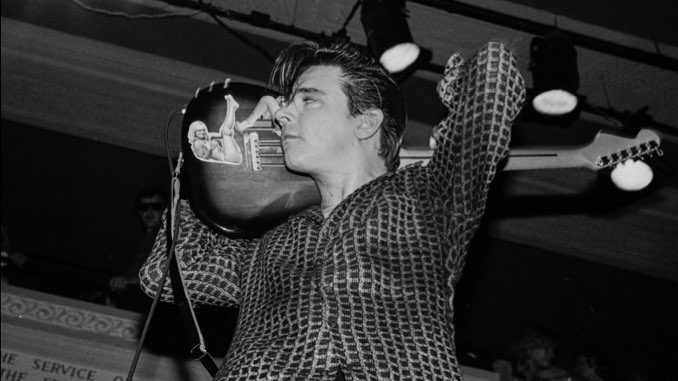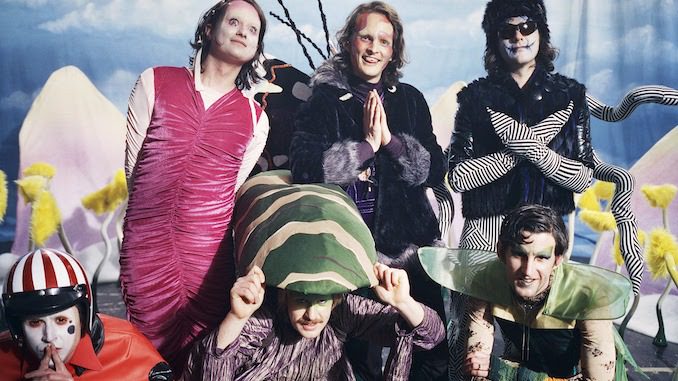Just before he died in a helicopter accident in 1990, Stevie Ray Vaughan recorded Family Style, a long-dreamed-of album, with his older brother Jimmie as the Vaughan Brothers. For this project, produced by Chic’s Nile Rodgers, the two siblings moved towards each other’s styles, with Stevie Ray playing fewer solos and more twangy riffs in the style of Lonnie Mack, and Jimmie playing more single-note solos in the style of Freddie King. But this rapprochement merely highlighted how differently they had played for most of their careers.
And that put a light on the different ways that modern musicians and audiences interpret the blues. The solos win the ovations, but the groove makes the music feel good. Soloists such as Stevie Ray, Eric Clapton and the three Kings (Albert, Freddie and B.B.) may be the guitar heroes, but the rhythm guitarists such as Jimmie, Keith Richards and James Brown’s Jimmy Nolen anchor the best bands. Maybe the groovers should be heroes, too.
That’s the argument made by the 2021 box set, The Jimmie Vaughan Story, which includes five CDs, one vinyl LP, two seven-inch vinyl singles and a hardcover picture book, an illustrated memoir. That’s 109 tracks in all, and what unifies it all is Vaughan’s rhythmic signature: pin-prick eighth notes right on the beat, a brusque downstroke to hammer on the one and a subtly delayed upstroke to make it swing, all soaked in a tone as thick and tasty as Texas barbecue sauce. Even when he plays a so-called “solo,” every new note settles into the push-and-pull rhythm.
It’s a style deeply rooted in Texas, especially in the Houston scene, where Gatemouth Brown, Bobby Bland and Big Mama Thornton made blues records with horn arrangements and a pulsing beat for dancers. Raised near Dallas, the Vaughan brothers moved to Austin where a new club, Antone’s, opened in 1975 and provided a showcase for the blues veterans from Chicago and Houston—and soon the young brothers’ own bands. The club also booked a lot of syncopated Louisiana acts—both blues and zydeco. Jimmie gravitated to the Gulf Coast riff masters, while his kid brother leaned to single-note soloists such as Buddy Guy and Jimi Hendrix.
The first 41 songs on the box set are taken from the albums of The Fabulous Thunderbirds, the Austin band Jimmie co-led with singer Kim Wilson, who played harmonica like a Houston saxophonist. This group—especially the 1979-1992 version with drummer Fran Christina and bassists Keith Ferguson or Preston Hubbard—made some of the most compelling blues records of their era.
These quartets excelled because no player tried to stand out from everyone else; everything—even the lead vocals and guitar solos—were tucked tightly within the groove. And no one was more self-effacing than Jimmie. This self-discipline resulted in records that hold up better today better than Stevie Ray’s more lionized efforts. It marks the distinction between great players and great bands. It’s a lesson that should be heeded by more young musicians playing the blues—or any roots music.
Those 41 songs include nine previously unreleased tracks: four from an unreleased debut album produced by Doc Pomus and Joel Dorn, and five live performances from 1979. They’re revealing, but the Thunderbirds hadn’t quite jelled into the rhythm machine they would become, in part because Jimmie hadn’t yet distilled his playing to its essence.
The rest of the box set offers two tracks from the Vaughan Brothers album, two tracks from Jimmie’s pre-T-Birds band Storm, selections from his many solo projects (including the first-ever vinyl release of his 2001 album Do You Get the Blues?), and his collaborations with such blues legends as Albert Collins, Bonnie Raitt, John Lee Hooker, Lazy Lester, B.B. King, Delbert McClinton, Billy Gibbons, Gary Clark Jr. and Eric Clapton. Sixteen of those 68 non-T-Bird tracks are also previously unreleased. Jimmie’s playing is always the glue in the music, but very few of these tracks offer a singer as persuasive as Wilson or a band as tight as the Thunderbirds.
The T-Birds weren’t the only band building on the long tradition of playing the blues as a kind of dance music. This was a common approach not only in Texas, but also in the neighboring states of Oklahoma and Louisiana, where audiences were more likely to step to the dance floor than on the East Coast or in the Midwest. The guitarists who perfected this style included not only T-Bone Walker in Dallas, Barbara Lynn in Beaumont and Albert Collins in Houston, but also Lowell Fulson in Tulsa and Earl King in New Orleans. Call it Gulf Coast Groove Blues.
These giants were always acknowledged by their disciples. Most of Jimmie Vaughan’s solo recordings featured Freddie King’s organist Bill Willis, and many of Sahm’s solo recordings featured Tejano saxophonist Rocky Morales. McClinton, who got his start backing up Sonny Boy Williamson, passed on the latter’s harmonica tips to a young John Lennon.
These apostles updated the sound with a dose of ’60s rock ‘n’ roll and brought that Gulf Coast sound into the national pop charts. San Antonio’s Sir Douglas Quartet, led by Doug Sahm and Augie Meyers, had a #13 pop single with “She’s About a Mover” in 1965. Tulsa’s J.J. Cale had a #22 hit with “Crazy Mama” in 1971. Fort Worth’s Delbert McClinton went to #8 in 1980 with “Giving It Up for Your Love.” The Fabulous Thunderbirds had a #10 pop single, “Tuff Enuff,” in 1986. They all proved that the blues could connect with a big audience if one could hum the tune and dance to it.
During the pandemic, Jimmie’s longtime partner Kim Wilson released a solo album, Take Me Back! The Bigtone Sessions, assembled from different sessions at the Southern California Bigtone Studio run by the album’s co-producer and guitarist, Big Jon Atkinson. Recorded in mono to get the vintage sound Wilson prefers, it definitely sticks to the Gulf Coast Groove Blues formula: tight, efficient arrangements with an emphasis on rhythm and feel. All 16 songs are less than four minutes long—and nine of them come in under three minutes. The seven Wilson originals are joined by blues classics from Percy Mayfield, Jimmy Rogers and Jimmy Nolen. Maybe it’s not A+ Wilson, but it’s at least a B+.
Z.Z. Top is the best-selling Gulf Coast Groove Blues act and perhaps the least interesting. This Houston trio, featuring two long beards and a clean-shaven guy named Beard (drummer Frank), was always entertaining, but they tended to flatten out the Texas swing into a hard-rock stomp and blues themes into cartoonish novelty songs. The band were effective ambassadors for the blues; they opened the door for a lot of listeners and worked hard to preserve neglected elements of blues history—such as Muddy Waters’ childhood home. But if they were the gateway to great music, the gateway itself was easily forgotten once one had passed through.
With the death of bassist Dusty Hill this summer, the future of Z.Z. Top is uncertain. But just before Hill passed, lead singer and guitarist Billy Gibbons released a new solo album, Hardware, in the familiar blues-rock trio format with drummer/producer Matt Sorum. There are a few wrinkles—a cover of Augie Meyers’ “Hey, Baby, Que Paso” and a spoken-word tribute to the desert—but mostly it’s blues-rock sludge scaled for basketball arenas.
On the other hand, this year’s best new recording of Gulf Coast Groove Blues comes from a relative unknown. Seth James, who grew up on a West Texas ranch, made a promising solo album, That Kind of Man, in 2009 and later co-led a band with Red Dirt Music star Cody Canada. The white cowboy hat he wears on the cover of his new album, Different Hat, implies that James is channeling George Strait, but he’s actually come back to his first love, the blues, and the singer-guitarist gives them the push-and-pull funkiness of Wilson or Delbert McClinton.
James not only sings McClinton’s “Solid Gold Plated Fool,” but even enlists the composer’s former duo partner Glen Clark to sing harmony. He gives obscure tunes by NRBQ’s Al Anderson, The Band’s Robbie Robertson and country outlaw Larry Jon Wilson some helpful Texas swing. The source of James’ relaxed, confident feel is explained by his two J.J. Cale covers—including a song, “Raisin’ Kane,” that Cale never released. James does it as a finger-snapping duet with ’90s country star Lee Roy Parnell.
All these influences are synthesized into James’s eight originals, most of them co-written with producer/keyboardist Kevin McKendree. The latter supplies the second-line New Orleans piano on “Big Trouble,” anchored by Jim Hoke’s baritone sax riff. But the lyrics are more than mere party fodder; they tell a real story about a kid who keeps pushing his luck until he pushes too far. The slow blues, “World Full of Strangers,” captures the loneliness and despair of the title with an understated vocal and big horn-section chords. All in all, this is a terrific coming-out for an overlooked talent.
Kevin Russell first made his name as co-leader of The Gourds, a popular but unremarkable Americana band. When that Austin group broke up in 2013 after a 19-year run, Russell turned a side project called Shinyribs into his full-time band. It was a smart move, for the new group’s fusion of Austin songwriting and Louisiana swamp-pop gave it a distinctive identity. Russell’s new hedonism anthems worked because the tunes were catchy and the bottom was jumping. This was especially true when he added a horn section and female singers to the live show.
When Russell prowled the main stage at Merlefest in September, he was playing a character named Shinyribs in much the same way that Mac Rebennack often played a character known as Dr. John. Much like the latter, Russell’s Shinyribs wears outlandish outfits (white porkpie hat, gold tie, baby-blue vest and pointy gray beard at Merlefest), does funny dances to the swampy syncopation and sings about finding life’s pleasures in an unfair world. With that big band behind him, he’s almost as transporting as Dr. John himself.
His new album, Late Night TV Gold, suffers from being made during the pandemic when Russell couldn’t gather the whole crew together. A much better introduction to his take on the Gulf Coast Groove Blues is the 2019 Shinyribs album, Fog & Bling.
In the memoir that’s part of The Jimmie Vaughan Story box set, Jimmie writes, “Maybe someday, Kim and Fran and I can get back together and do some more recording and maybe another tour. What do you think?”
As tempting as it is to imagine a Fabulous Thunderbirds reunion, the reality is that it would be hard to recapture the special chemistry of that band’s early years. Instead, the future of the Gulf Coast Groove Blues will probably come from as-yet-undreamed-of twists on the old tradition. After all, who would have thought you could link T-Bone Walker to Prince until Gary Clark Jr. did it? It seemed so obvious in retrospect, but no one had thought of it before he did. Who knows what the musicians in Texas, Louisiana and Oklahoma will come up with next?
Watch Jimmie Vaughan’s October 2021 Paste session below.




